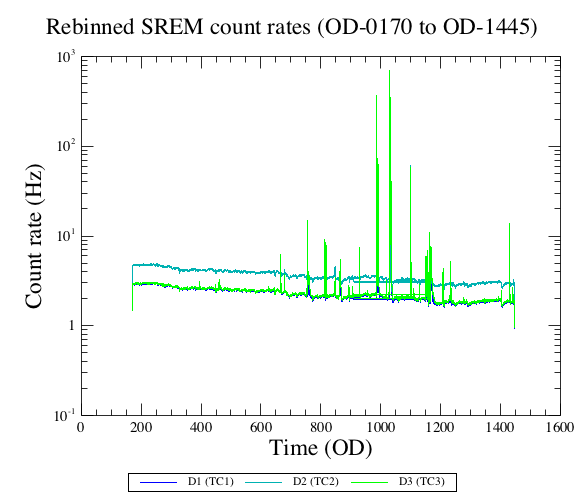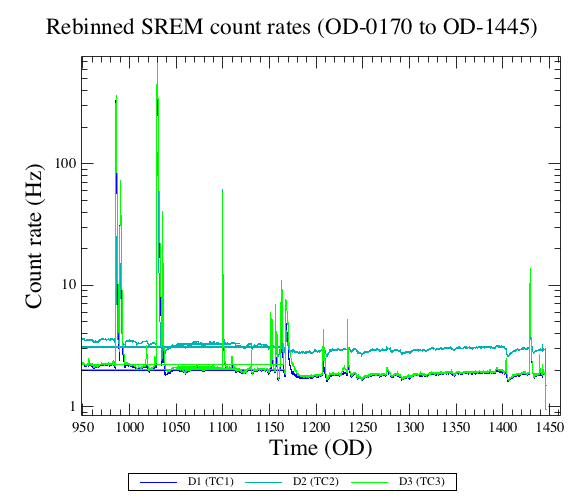Spacecraft & Observatory - Herschel
Spacecraft and observatory web pages
General information
- The Herschel spacecraft has a modular design. On the left, facing the "warm" side and on the right, facing the "cold" side of the spacecraft, the middle image names the major components.:
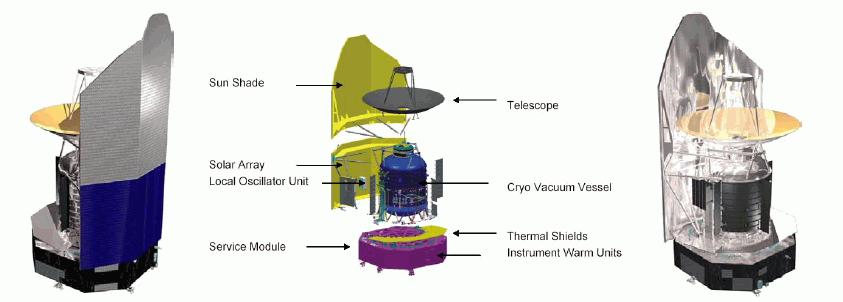
* Herschel Observers' Manual (HTML) and PDF (6.2 MB)
Pointing calibration and performance
- Plan
- Pointing calibration report, v1.0 (November, 2009): pointing_calibration_report_v10.pdf
- Paper on the pointing system of the HSO, including a description, calibration, performance and improvements (Sánchez-Portal et al, 2014, Experimental Astronomy, Volume 37, Issue 2, pp.453-479). Can be found at the Experimental Astronomy web page
 or astro-ph
or astro-ph
- Spacecraft/instrument alignment matrix historical record
The table below shows the recent SIAM update history (from OD299 onwards) showing the SIAM file used in up-link and the suggested down-link one. The SIAM matrices are a component of the auxiliary context inside the observation context.
| OD range | SIAM used in uplink | SIAM used in pipeline | Suggested reprocessing SIAM | Comment |
| 299 | 0122_0001 | 0122_0001 | 0341_0001 | The temperature of the STR CCD was lowered to -10 degC to carry out the pointing calibration campaign at the new reference temperature. Raised again at the following DTCP |
| 300-319 | 0122_0001 | 0122_0001 | 0122_0001 | STR CCD reference temperature set back to +13 degC |
| 320-329 | 0320_0001 | 0341_0001 | 0341_0001 | STR CCD temperature lowered permanently to -10degC. The SIAM used in uplink was computed using incorrect offsets (reversed signs in both Y and Z offsets) resulting in target misalignment of some 10 arcsec. The use of a correct SIAM in downlink fixes the astrometry problems |
| 330-339 | 0320_0002 | 0341_0001 | 0341_0001 | New SIAM computed with correct Y, Z offsets |
| 341-342 | 0341_0001 | 0341_0001 | 0341_0001 | Some refinements based on pointing measurements carried out in OD330 |
| 343-353 | 0320_0002 | 0341_0001 | 0341_0001 | |
| 354-... | 0341_0001 | 0341_0001 | 0341_0001 |
- A quite complete summary of the pointing performances during operations can be found here. See also the Experimental Astronomy paper
 . For information on current pointing figures based on ground-reprocessing, see here.
. For information on current pointing figures based on ground-reprocessing, see here.  A technical note on the Absolute Pointing Error (the estimation of its 68th percentile from calibration observations): CAS_APE_calc_1p1.pdf
A technical note on the Absolute Pointing Error (the estimation of its 68th percentile from calibration observations): CAS_APE_calc_1p1.pdf
Important pointing links
- Periods of anomalous pointing during the Herschel mission due to star-tracker switch-overs and lack of aberration correction.
 Improved pointing information from ground-based processing using gyro-reconstructed attitude
Improved pointing information from ground-based processing using gyro-reconstructed attitude- Improved pointing information from "simple" ground-based processing (OBSOLETE)
 Astrometry correction for observations affected by a thermoelastic drift
Astrometry correction for observations affected by a thermoelastic drift- Original page on improved pointing information, now superseded by the links above but still containing useful information
Spacecraft health monitoring
Spacecraft temperature tracking
- The figure below shows the temperature evolution of the main mirror (M1), the Cyo Vacuum Vessel (CVV) and the Sun-Shade (SS) of the Herschel Spacecraft since OD 50 (2009-07-02) to OD 630 (2011-02-02) plus M1 and CVV comparison to OD 1445 (2013-04-29):
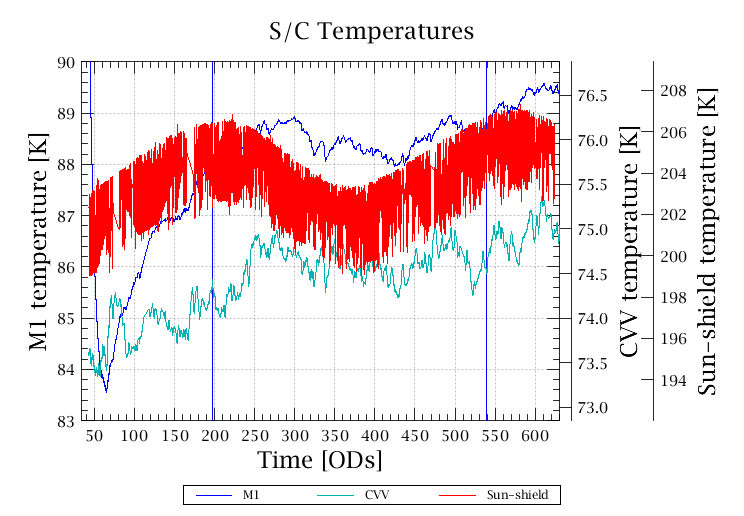
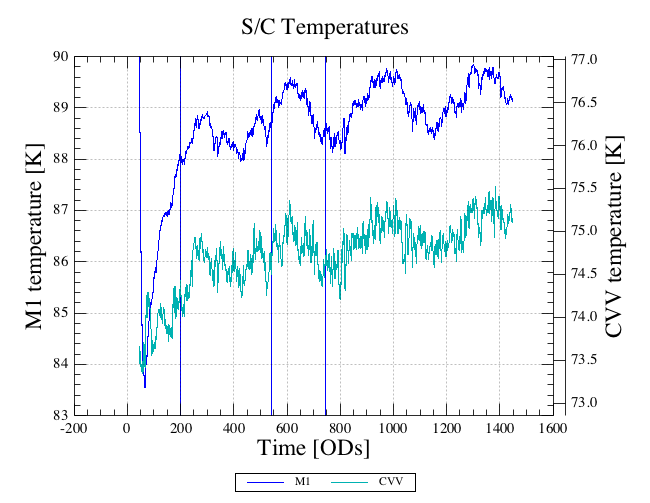
Radiation environment tracking
- The radiation monitor on-board Herschel is called SREM for Standard Radiation Environment Monitor. SREM raw and calibrated data products are delivered with the Herschel observations as part of the auxiliary context, inside the observation context. The SREM units detect and count electrons, protons and cosmic rays with a coarse spectral resolution and ±20◦ angular resolution. The measurements are based on silicon diodes polarized in reverse by a high voltage. The SREM consists of three detectors, D1, D2 and D3, mounted in two heads. One head consists of a single silicon diode (D3) and its main entrance window is covered with an aluminium plate of 0.7mm, defining a lower energy threshold of ~0.5MeV for electrons and ~10MeV for protons. The other head uses to silion diodes (D1/D2) arranged in a telescope configuration. The main entrance window is covered with an aluminum plate of 2mm providing a threshold of 1.5MeV for electrons and 20MeV for protons.
- SREM calibrated 5-minutes-rebinned counts from the 30th of October 2009 to 29 April 2013, a second plot zooming on the large solar Flares on the 23rd Jan and on the 7th of March 2012, the largest ever in the history of the Herschel mission:
